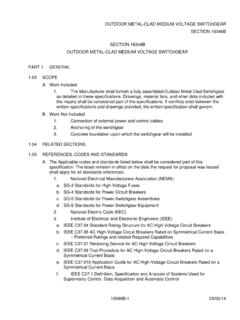Transcription of ANSI ASC X12N 837 Basics - Public Health Data …
1 The Evolution of the ansi ASC x12n 837 format from the UB-92 Flat file format Bob Davis, January 13, 2004 Introduction The purpose of this document is to provide background information on the ansi ASC x12n 837 standard format1 and to describe similarities and differences between this standard and the UB-92 format. The goals for this document are: 1. to provide the user with a structural overview of the UB-92 flat file format; 2. to provide the user with a structural overview of the ansi ASC X12 837 standard; and 3. to discuss the differences (gaps) and congruencies between the two formats. The document attempts to accomplish these goals using clear and logical language, without excessive technical jargon.
2 Overall, the ansi ASC X12 837 format and the UB-92 flat file format are more similar than they are different. Both formats are designed to support data content detailed in the institutional UB-92 data Specifications document maintained by the National Uniform Billing Committee (NUBC).2 Background The ansi ASC X12 837 standard provides the following text describing the purpose of this transaction set. This X12 Transaction Set contains the format and establishes the data contents of the Health Care Claim Transaction Set (837) for use within the context of an Electronic data Interchange (EDI) environment. This transaction set can be used to submit Health care claim billing information, encounter information, or both, from providers of Health care services to payers, either directly or via intermediary billers and claims clearinghouses.
3 It can also be used to transmit Health care claims and billing payment information between payers with different payment responsibilities where coordination of benefits is required or between payers and regulatory agencies to monitor the rendering, billing, and/or payment of Health care services within a specific Health care/insurance industry segment. For purposes of this standard, providers of Health care products or services may include entities such as physicians, hospitals and other medical facilities or suppliers, dentists, and pharmacies, and entities providing medical information to meet regulatory requirements. The payer refers to a third party entity that pays claims or administers the insurance product or benefit or both.
4 For example, a payer may be an insurance company, Health 1 It is not the intent of this document to educate the user on X12-837 transactions. This document must be used in conjunction with published ansi ASC X12 implementation guides. 2 This document is available for a membership fee on the NUBC Web site at Page 1 maintenance organization (HMO), preferred provider organization (PPO), government agency (Medicare, Medicaid, Civilian Health and Medical Program of the Uniformed Services (CHAMPUS), etc.)
5 Or an entity such as a third party administrator (TPA) or third party organization (TPO) that may be contracted by one of those groups. A regulatory agency is an entity responsible, by law or rule, for administering and monitoring a statutory benefits program or a specific Health care/insurance industry segment. 3 The Health Care Service data Reporting Guide (HCSDRG) derives its name from the language above that permits use of the 837 standard for use in reporting Health care services. This is the same standard that is used to report institutional claim adjudication information for payment to private and Public payers. Separate 837 implementation guides have been developed by the ansi ASC x12n Task Group 2 Work Group 2 for payment of institutional, professional, and dental Health care claims.
6 A fourth implementation guide has been written for the reporting of Health care services. It has been given the following name by the ansi ASC x12n organization: existing de facto standard for reporting Health services performed in an institutional setting to Public and private entities on a mandated and voluntary basis is the UB-92 flat file Though this format has been widely used for this reporting purpose across the country by state and private entities, this standard is a proprietary format maintained by Medicare. Since different states have different reporting requirements, the UB-92 flat file format reserves data elements and record types for individual state assignment.
7 The HIPAA legislation will make the current UB-92 flat file formats maintained by Centers for Medicare and Medicaid Services obsolete once HIPAA transactions and codes are fully implemented. For advocates of standards, the UB-92 flat file format has 3 inherent problems: 1. Changes in the data elements and record types shared with Medicare are subject to the proprietary needs of the Medicare program. 2. Individually defined state data elements and record types promotes a non-standard solution for state data collection systems. 3. After the HIPAA transactions and codes law is implemented, this format will no longer be maintained even for the proprietary Medicare Format Overview Both the 837 and the UB-92 formats support the reporting of information referred to here as what is wrong with the patient, what services did the patient receive, how much does it cost information.
8 Information in the what is wrong with the patient category includes diagnoses and disposition of the patient related to an episode of care. Information in the what services 3 Scope and Purpose of Health Care Claim Transaction (837) standard. 4 This implementation guide is a technical document that can be downloaded from the Washington Publishing Company web site: 5 De facto standards are those standards that are defined for a specific purpose and then, due to their usefulness, adopted by industries for widespread use. Tutorial Module 5: Public Health data Standards. Web-based Resource Center. Public Health data Standards Consortium.
9 Available online: Accessed on January 13, 2004. 6 The Medicare version of this format can be downloaded from the following web site: Page 2 did the patient receive category includes procedures, while information in the how much does it cost category includes the charge information related to that same episode of care. Both formats also support the reporting of patient demographics for identifying and statistical purposes. The structure of how each format accomplishes the reporting of this information is different and will be the main topic of discussion for the remaining sections of this paper.
10 UB-92 Flat File Format Basics The data content in the UB-92 flat file format is predominately the data defined by the National Uniform Billing Committee in the UB-92 Specifications Document, which is available on the NUBC web site ( ). UB-92 flat file is organized by Record Types and data elements within those record types. Each of the record types is a fixed record length of 192 characters of information that is logically arranged by categories of information. It takes several record types to completely report a single episode of care. The record types for a single episode of care are linked together by a patient control number, which is typically the billing number.






